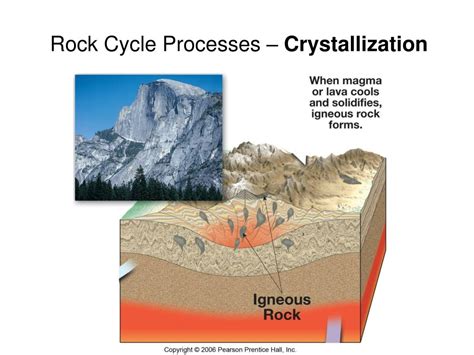What Does Crystallization Mean? How Does it Relate to Igneous Rocks?
Crystallization is a process that leads to the formation of crystals. It involves the arrangement of atoms or molecules into a highly ordered, repeating pattern, forming a solid structure. This happens when a substance transitions from a liquid or gaseous state to a solid state, usually due to a decrease in temperature or an increase in concentration. Understanding crystallization is key to understanding how igneous rocks are formed.
Understanding the Crystallization Process
Several factors influence the size and shape of crystals that form during crystallization:
-
Cooling Rate: Slow cooling allows atoms more time to arrange themselves into a well-ordered structure, resulting in larger crystals. Rapid cooling, on the other hand, traps atoms in place before they can fully organize, leading to smaller crystals or even a glassy texture.
-
Viscosity: The viscosity (thickness) of the liquid also plays a role. High-viscosity liquids hinder the movement of atoms, slowing down crystallization and potentially leading to smaller crystals.
-
Presence of Impurities: Impurities in the liquid can interfere with the orderly arrangement of atoms, affecting crystal growth and potentially leading to imperfections or a change in crystal habit (shape).
Crystallization and Igneous Rocks: A Perfect Match
Igneous rocks are formed from the cooling and solidification of molten rock (magma or lava). Crystallization is the fundamental process behind the formation of igneous rocks. The size and type of crystals present within an igneous rock are directly related to the cooling conditions under which it formed.
Intrusive vs. Extrusive Igneous Rocks: A Crystal Size Tale
-
Intrusive Igneous Rocks: These form when magma cools slowly beneath the Earth's surface. The slow cooling allows for the growth of large, visible crystals, resulting in phaneritic textures. Examples include granite and gabbro.
-
Extrusive Igneous Rocks: These form when lava cools rapidly at the Earth's surface. Rapid cooling leads to the formation of small, often microscopic crystals, resulting in aphanitic textures. Examples include basalt and obsidian (which is glassy due to extremely rapid cooling). Sometimes, you'll see a porphyritic texture, where larger crystals (phenocrysts) are embedded within a finer-grained matrix. This suggests a two-stage cooling process.
The Role of Composition
The chemical composition of the magma also affects the type of crystals that form. Different minerals crystallize at different temperatures and under different conditions. This leads to a variety of igneous rocks with unique mineral compositions and textures. For example, felsic magmas (rich in silica) tend to form lighter-colored rocks like granite, while mafic magmas (lower in silica) tend to form darker-colored rocks like basalt.
Beyond Igneous Rocks: Crystallization in Other Rock Types
While crystallization is most prominently associated with igneous rocks, it also plays a role in the formation of metamorphic rocks. During metamorphism, existing rocks are subjected to high temperatures and pressures, causing changes in their mineral composition and texture. Crystallization can occur as minerals recrystallize into new, more stable forms under these conditions.
Conclusion: Crystallization – A Fundamental Geological Process
Crystallization is a fundamental geological process essential to understanding the formation of a wide range of rocks, especially igneous rocks. The rate of cooling, viscosity of the melt, and chemical composition all influence the final crystal size, shape, and mineral assemblage, leading to the incredible diversity of rock types we observe in the Earth's crust. Understanding crystallization provides a key to unlocking the secrets of our planet's geological history.
